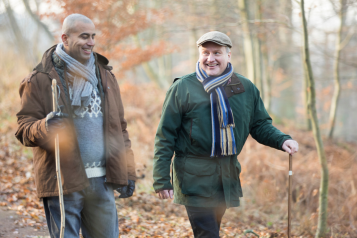What are fibroids?

Fibroids are growths that develop in or around the womb. These are called uterine fibroids and are not cancer.
They can vary in size. Some can be as small as a pea, while others can be the size of a melon.
Fibroids are made up of muscle and fibrous tissue similar to the wall of the womb. They are also called leiomyomas or uterine myomas.
Around 1 in 3 women develop at least one fibroid at some point in their life. They mostly happen in women aged 30 to 50.
The main types of fibroids:
- intramural fibroids develop within the muscle wall of the womb
- subserosal fibroids develop towards the outside wall of the womb into the pelvis
- submucosal fibroids develop in the muscle layer beneath the womb’s lining and grow in the cavity of the womb
What are the symptoms of fibroids?
Many women don’t know they have fibroids and don’t have any symptoms.
Around 1 in 3 women with fibroids may get symptoms.
These can include:
- heavy periods
- painful or irregular periods
- tummy pain
- lower back pain
- a frequent need to pee
- constipation
- pain during sex
It’s rare, but fibroids can affect pregnancy or cause problems with getting pregnant (infertility).
Symptoms related to fibroids can have a negative impact on your everyday life. You may have poor sleep, low mood and difficulties with work and relationships.
Who gets fibroids?
You may be more likely to get fibroids if:
- you are of African-Caribbean origin
- you are overweight
What causes fibroids?
We do not know the exact cause of fibroids.
Fibroids have been linked to the female reproductive hormone called oestrogen. Fibroids usually develop in women before menopause when oestrogen levels are at their highest.
After menopause, when the oestrogen levels fall, fibroids typically shrink.
When should I get help for fibroids?
As many women don’t have symptoms, fibroids can be diagnosed by chance during a routine test or examination. Since they are non-cancerous growths, which shrink after menopause, treatments are only generally needed if they cause symptoms.
If you have any symptoms, speak to your GP. They will talk to you about your symptoms and may examine you, organise tests and start treatments.
Your GP may refer you to hospital for further tests if needed.
You won’t need treatment if your fibroids aren’t causing any symptoms. They’ll often shrink without treatment once you go through the menopause.
If your periods are heavy, there are medicines, such as tranexamic acid, hormonal contraceptives, or Mirena coil, to help.
You may be offered treatment with other specific hormonal treatments or special treatments (such as uterine artery embolization), to shrink your fibroids. Surgery also may be an option to either remove just the fibroids or the entire womb.
The NHS website has more information on the different treatments for fibroids.
It’s ok to ask questions about your care so you can get the information you need. You could ask about your treatment options and the benefits and risks of each. This can help you decide what’s right for you.
What can I do to manage my fibroids?
Fibroids can have a big impact on your life. As well as getting treatment from your doctor. you could try:
- Heat pads, ice packs or a TENS machine can relax your muscles or numb pain.
- Exercising, eating a balanced diet, drinking less alcohol and stopping smoking.
- Increasing fibre in your diet and drinking at least two litres of water a day helps to regulate your bowels and reduce bowel symptoms sometimes associated with fibroids.
- Alternative therapies and lifestyle changes. Yoga, mindfulness and meditation might improve your wellbeing.
How will having fibroids affect my fertility?
Some fibroids can cause problems with getting pregnant (infertility), but most do not.
If you have fibroids that are growing into the cavity of your womb, it may interfere with an embryo being implanted. This could reduce the chance of pregnancy. You should discuss these issues with your GP, and they can refer you to specialist for treatment if necessary.
Fibroids and pregnancy
Pregnant women with fibroids may get discomfort and tummy pain. There’s also a small risk of going into labour early (premature labour).
If fibroids are large and located lower in the womb near the birth canal, they can cause problems with blocking the birth-canal and delivery. Large fibroids can sometimes cause babies not to face head-first down the birth canal as birth approaches (malpresentation). Very rarely this might mean you may need a caesarean to deliver the baby.
After delivering the baby, women with fibroids are at risk of excessive bleeding (post-partum haemorrhage), but there are treatments for this. It is best that you deliver your baby in a hospital.
In rare cases, fibroids can cause a miscarriage. Although a small number of women may experience other issues such as miscarriage or pregnancy complications, most women with fibroids may not have problems conceiving or carrying a pregnancy and having a baby.
Your GP or midwife can give you advice about fibroids in pregnancy.
Where to go for more support
- The British Fibroid Trust is a charity providing support and information.
- If you’re looking to find a community of other women experiencing fibroids, you can join Responsum for Fibroids.
- There’s more information about fibroids from the NHS.
To read this article from its original source, peoples stories, other women's issues and much more, visit Wellbeing of Women
Click here to read more on Dawns Story
Join the Just a Period campaign
The image used for this article has no direct link to the content and has been supplied through Canva


